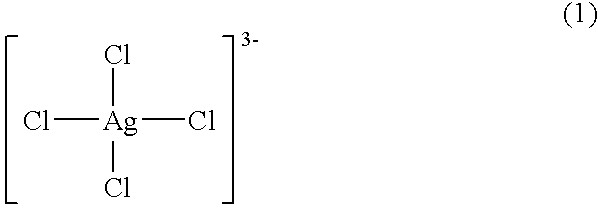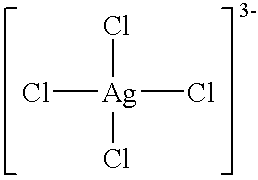Antimicrobial agents
a technology of antimicrobial agents and antimicrobial agents, applied in the field of antimicrobial agents, can solve the problems of inability to inhibit, social problems, and need for counter-measures against these infections, and achieve the effects of wide disinfection spectrum, good safety, and prevention of resistant bacteria
- Summary
- Abstract
- Description
- Claims
- Application Information
AI Technical Summary
Benefits of technology
Problems solved by technology
Method used
Image
Examples
example 1
The present example examined stability of the antimicrobial agent solution.
Firstly, an antimicrobial agent solution (solution C) was prepared as the first antimicrobial agent in accordance with the present invention by mixing, in the volume ratio of 1:1, an aqueous solution (solution A) containing 35 percent by weight of sodium chloride and the silver-chloro complex salts in the silver ion concentration of 500 ppm with an aqueous solution (solution B) of sodium hypochlorite containing 137 g / l of effective chlorine. The concentration of the silver-chloro complex salts in the antimicrobial agent solution was about 3.times.10.sup.2 mg / l in silver ion equivalent concentration.
These solutions A, B, and C were stored for 50 days under the condition of 30.degree. C. and change in the amount of effective chlorine and change in solution state were measured for each solution. Table 1 shows the results of observation of the amount of effective chlorine (g / l) and the solution state at the start...
example 2
The present Example examined antimicrobial effect on Staphylococcus aureus.
First, using the antimicrobial agent solution (solution C) of Example 1, antimicrobial effect on Staphylococcus aureas was evaluated. Further, as a control, the same evaluation was made using the sodium hypochlorite solution (solution B). The testing method is as follows.
A floor plate made of linoleum was cut into pieces of 10 cm.times.10 cm, which were then boiled for an hour four times in water including a neutral detergent so as to remove a plasticizer, etc. On these floor plates were independently sprayed the solution B diluted 200 times and the solution C diluted 100 times using a sprayer in the amount of 1 ml per floor plate. Spraying was repeated at predetermined intervals of four four patterns: everyday, every other day, every three days, and every six days. Also, on each floor plate was sprayed an inoculum of Staphylococcus aureus in the concentration of 10.sup.2 CFU (Colony Formation Unit) / ml on the...
example 3
The present example compared a growth rate of bacteria using the antimicrobial agent in accordance with the present invention and a comparative antimicrobial agent which did not include the oxidizing agents.
Firstly, a silver-chloro complex salt solution (solution a) was prepared as the comparative antimicrobial agent by dissolving 35 g of calcium chloride and 0.05 g of silver chloride in 100 ml of water. Also, an antimicrobial agent solution (solution b) was prepared as the first antimicrobial agent in accordance with the present invention by adding 3 parts by volume of a 4.3 percent by weight solution of sodium hypochlorite with respect to 7 parts by volume of the solution a.
Then, the Trypto-Soya Broth "Nissui" (TSB) medium (provided by NISSUI PHARMACEUTICAL Co., Ltd.) was adjusted to have a pH of 7.2 and was sterilized for 15 minutes at 121.degree. C. and divided into two equal parts. To each of the two parts was added the solution a or solution b in the amount of 0.1 percent by w...
PUM
 Login to View More
Login to View More Abstract
Description
Claims
Application Information
 Login to View More
Login to View More - R&D
- Intellectual Property
- Life Sciences
- Materials
- Tech Scout
- Unparalleled Data Quality
- Higher Quality Content
- 60% Fewer Hallucinations
Browse by: Latest US Patents, China's latest patents, Technical Efficacy Thesaurus, Application Domain, Technology Topic, Popular Technical Reports.
© 2025 PatSnap. All rights reserved.Legal|Privacy policy|Modern Slavery Act Transparency Statement|Sitemap|About US| Contact US: help@patsnap.com



